- Home
- Encyclopedia
- Who Gets To Hunt Wyoming’s Elk? Tribal Hunting ...
Who gets to hunt Wyoming’s elk? Tribal Hunting Rights, U.S. Law and the Bannock ‘War’ of 1895
On July 13, 1895, a party of Bannock Indians awoke in their camp to find themselves surrounded by 27 armed White men. The Bannock party resembled a family reunion, with nine men, 13 women and five children camped near the confluence of the Hoback River and Granite Creek, about 30 miles southeast of today’s Jackson, Wyo. They had traveled from the Fort Hall reservation in Idaho to hunt elk, as they always did, and as was clearly permitted in their treaty with the U.S. government. They had avoided White settlements and harvested only enough meat to feed themselves through the winter.
Today, the area around Jackson is known for tourism, scenic beauty, wilderness and elk. In 1895, the elk were seen as the key to the region’s economy and future. For the 60 or so White people who lived on homesteads scattered across the area, Indian elk hunting was a threat. So the Whites initiated what is sometimes called the Bannock War of 1895—although, as we will see, the Bannocks never fired a shot.
That July day of terror for the Bannocks led to a summer of hysteria for the Whites. The tensions were “resolved” in a much-maligned 1896 U.S. Supreme Court decision, known as the Race Horse case. More than a century later, in a 2019 case known as Herrera, the Supreme Court fully repudiated its Race Horse principles. The question of how to combine indigenous peoples’ treaty-reserved hunting rights with Wyoming’s conservation and land management regulations can now be resolved all over again, this time, one would hope, with justice for all.
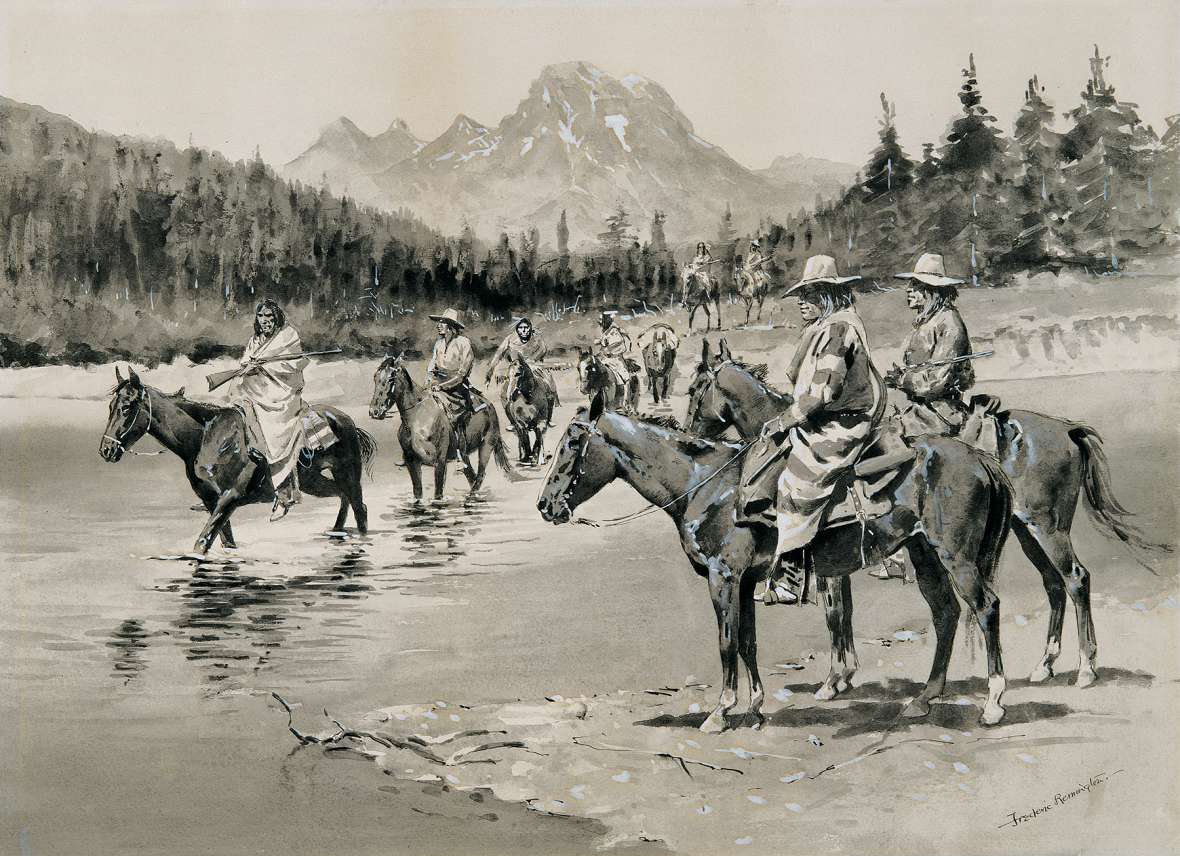
Causes of the 1895 war
Traditional Bannock lifestyles had involved seasonal migrations, including winters in the bottomlands of Idaho’s Snake or Bear Rivers, and large spring and fall gatherings to organize hunting parties in the high country of what is now northwest Wyoming. In the 1860s, as Whites began migrating through the area, fights erupted with the Bannock and their allies, the Shoshone, including on Jan. 29, 1863, when White troops massacred hundreds of indigenous people at Bear River, near today’s Preston, Idaho.
The Fort Bridger Treaty of 1863 assigned Bannock, Shoshone and associated tribes a 44-million-acre reservation across large swaths of today’s Wyoming, Idaho, Utah and Nevada. But the federal government failed to enforce that treaty against encroachment from miners, buffalo hunters, migrants, agriculturalists, members of displaced Great Plains tribes and others. In the Fort Bridger Treaty of 1868, the tribes gave up the vast majority of those lands, with the Eastern Shoshone selecting the Wind River reservation, near today’s Lander, Wyo., and the Bannock, after a five-year delay, selecting the Fort Hall reservation, near today’s Pocatello, Idaho.
The 1868 treaty stipulated that the tribes “shall have the right to hunt on the unoccupied lands of the United States so long as game may be found thereon, and as long as peace subsists among the Whites and Indians on the borders of the hunting districts.” A treaty signed with the Crow tribe the same year contained identical language.
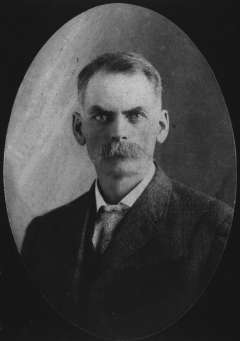
Those hunting rights were important for two reasons. First, many indigenous cultures see people as part of nature (rather than separate from it), and thus hunting not only as a form of natural regulation, but also as an expression of connection between an individual and the wider natural world. In agreeing to live on a reservation, Bannock, Shoshone and Crow people weren’t giving up that philosophy.
Second, Whites failed to fulfill their treaty obligations to provide the Fort Hall tribes with sufficient rations, or tools for farming on the reservation. Bannocks had to hunt or starve. On subsistence hunting trips, a party would receive a pass from the reservation’s Indian agent, written in English so that anyone who encountered them could confirm the legitimacy of their trip. Unlike White settlers, indigenous people had methods of drying and preserving meat to eat through the winter. They could also use elk hides, or sell the hides, often to White merchants.
Whites first permanently settled Jackson Hole in the late 1880s. They centered on a post office called Marysvale, located near today’s town of Jackson. Harsh winters meant difficult farming, but scenery and wildlife drew sport hunters. Many locals, including Stephen N. Leek, who arrived in 1888, made their living as guides.
By the early 1890s, Jackson Hole elk populations were dwindling. In retrospect, it’s clear that much of the problem was habitat. White homesteaders and their fences had disrupted elk migrations and winter ranges. But at the time, attention centered on overhunting. Shortly after statehood in 1890, Wyoming passed regulations to create hunting seasons and limits to try to conserve wildlife. But it did little enforcement, especially in Jackson Hole, which was then part of Uinta County, with the county seat of Evanston almost 250 miles south.
Who overhunted? Whites in Jackson Hole claimed that Bannock and Shoshone engaged in “wanton slaughter” of elk. Jackson Hole residents claimed that Indians killed elk for only the commercial value of their hides. The administration of nearby Yellowstone National Park also focused on Indian depredation. Beginning in the 1880s, Yellowstone superintendents complained to Indian agents that traveling parties of indigenous people decimated Yellowstone wildlife populations.
The administrators believed that once Yellowstone became a national park, it was no longer the “unoccupied land” where Indian treaty hunting rights applied. It was now occupied by a national park. South of the park, as homesteads started dotting Jackson Hole, residents believed that their entire valley was just as “occupied” as Yellowstone, if not more so.
However, evidence suggests that Whites in Jackson Hole were responsible for more elk slaughter than Indians. For example, memoirs of Jackson Hole settlers’ children uniformly recalled eating elk and venison meat year-round. Unlike the Indians, few Whites were skilled at preserving meat in summer months, so often left much to rot. And visiting hunters wanted trophies such as antlers or elk teeth, not meat. In 1901, for example, a party of eight hunters with two guides killed 59 elk.
Lt. John T. Van Orsdale, former agent of the Fort Hall reservation, noted in 1895 that “it is a notorious fact that hundreds of animals are killed by white men for nothing more than heads and horns. There are men in that country who make it a business to pilot hunting parties from the East and the Old Country which not only slaughter elk but capture and ship them out of the country. The killing of game by Indians interferes with their business.”
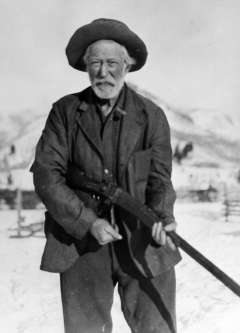
The influence of guiding—which in Jackson Hole would evolve into the broader industry of dude ranching—is unusual in the history of White-Indian conflicts. These traditionally involved White migrants and settlers, not tourism promoters. Even when clashes centered on off-reservation hunting rights—as, for example, in New Mexico’s Gila National Forest and Montana’s Glacier National Park from the 1890s to the 1910s—the White hunters were typically locals. In Jackson Hole, however, the White interest in elk populations was not for the subsistence or even the sport of local residents. It was instead for profit by catering to wealthy recreational hunters from elsewhere.
Tensions mount
In the fall of 1894, Jackson Hole residents elected a constable, William Francis Manning (1836-1932), and a justice of the peace, Frank Rhoads, who promised to enforce game laws that the state of Wyoming was unable or unwilling to enforce. Rhoads reportedly claimed two months afterward that Governor William Richards directed him before the shootings to "enforce the laws of Wyoming, [to] put the Indians out of Jackson's Hole, to keep them out at all costs, [and] to depend upon him [that is, Richards] for protection.” Richards later denied this, however, and the letter he wrote to Manning on the subject has not survived..
On June 7, 1895, Manning arrested three Bannocks and confiscated their elk hides. Rhoads fined their leader $15 (about $450 in 2020 dollars), which was paid by a friend. About June 24, Manning and a posse arrested nine more Bannocks. Rhoads fined them as well, but they didn’t have any money. Eventually the Whites tired of the expense of jailing the Indians and told them to escape.
“The officers and settlers soon found out that they had started something that, without help, would be very hard to carry through,” wrote Stephen Leek in a memoir years later. “Something more serious than arrest and conviction had to take place; an Indian or a white man had to be killed before there would be relief.”
However, Manning’s testimony later in 1895 suggests that Whites’ plans for violence were deep-rooted, rather than based on circumstance. “We knew very well when we started in on this thing that we would bring matters to a head. We knew some one was going to be killed, perhaps some on both sides, and we decided the sooner it was done the better, so that we could get the matter before the courts.”
On June 30, Manning and three deputies accosted a very large Bannock party that refused to be arrested. Manning backed down, but only temporarily. The Whites had to follow through, Leek wrote, or become “the laughing stock of the Indians who, we knew, would then become intolerable.” In response, Rhoads swore in 38 men as deputies, and wrote a warrant for the Indians’ arrest. Without names or even a number of Bannocks to be arrested, the warrant was probably illegal. But the settlers’ will was strong.
The posse first ran into a large party of Eastern Shoshone, headed back to their Wind River Reservation. “For a time excitement ran high and a spark would have brought on a battle,” Leek wrote. “The outcome would have meant some good Indians; but owing to the close quarters and determined actions of those same Indians there would have been some mourning among the whites also.”
There was a racist saying at the time, “The only good Indian is a dead Indian.” (It’s generally attributed, perhaps incorrectly, to General Philip Sheridan.) Leek not only expected people to be so familiar with the “good Indian” saying that he could allude to it without explanation, he also intended to apply it to real, live, unarmed Indians he met in the flesh.
The incident ended peacefully, but when the Shoshone told the Whites that they’d recently departed from a more warlike party of Bannock, White fears only increased.
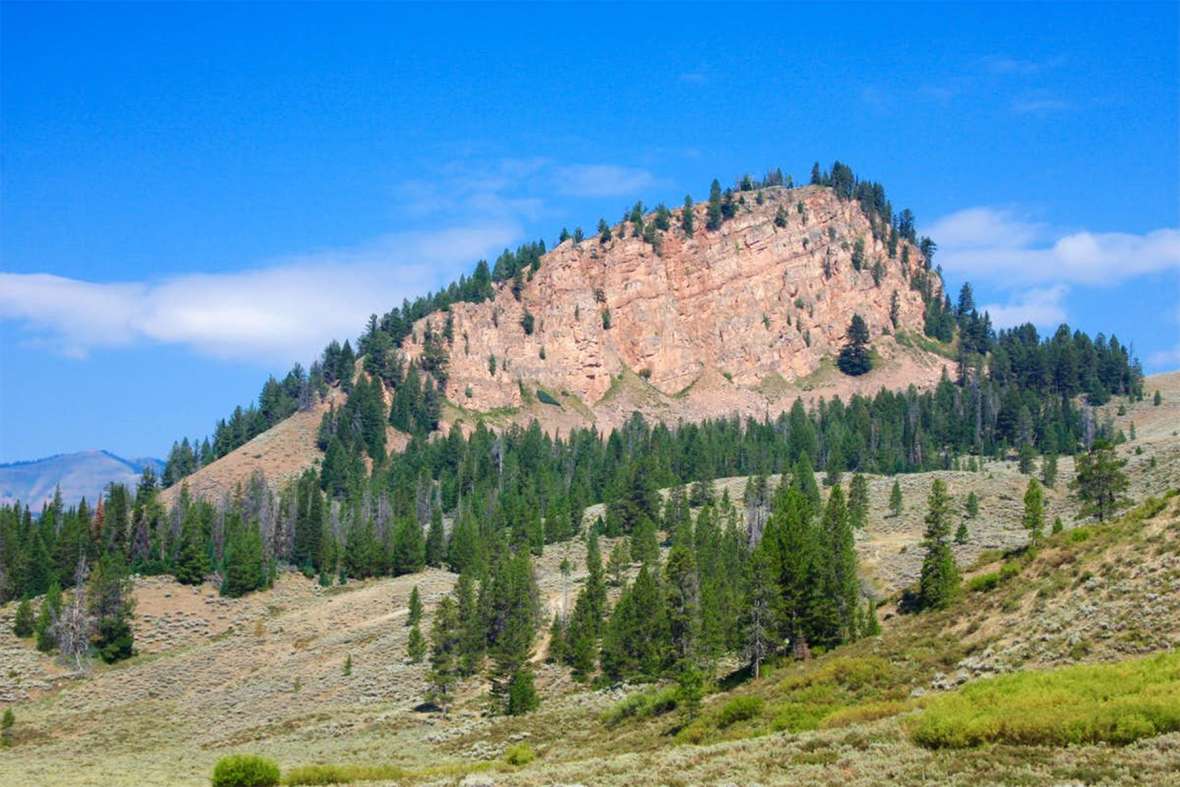
A fateful day
After regrouping, the posse was reduced to 26 deputies. To surprise the Bannocks, rather than traveling up the Hoback drainage, they ascended nearby Cache Creek and then moved south. They found a Bannock camp, at a place now called Battle Mountain, and circled it during the night. At daylight, they arrested the Bannocks, who put up no resistance. “These Indians surrendered gracefully,” Leek wrote, adding, “too much so we thought.” He expected “treachery or attempts to escape.”
The Bannocks, led by a man named Ben Senowin, were not the same party that had repelled the previous posse. But they’d been hunting elk, so the Whites used the warrant to arrest them and confiscate their hides. They began a long march toward town.
Senowin later said that the Bannocks were not fully aware of the charges against them. Even if they had been aware, they would have found the charges groundless. Manning was not enforcing anti-poaching laws against Whites, who were clearly subject to those laws. Instead he was targeting only Bannock, whose treaty exempted them from those laws. Senowin’s party was harmlessly executing those rights complete with a pass from their Indian agent. Manning’s deputies confiscated that pass, as well as their ration checks, without which they might starve if they returned to the reservation without meat.
The party marched all day. The deputies told several Bannock men that they were in big trouble, and might even be hanged. Deputies also said that in the case of an escape attempt, they’d been instructed to shoot the horses first. Such comments were likely intended to encourage the Bannocks to attempt to escape, which would give the Whites an excuse to shoot—despite the fact that the misdemeanor for which the Bannocks had not yet been tried carried a maximum penalty of a $15 fine and three months’ imprisonment, and despite the fact that having confiscated their paperwork, Manning knew their names and could have them re-arrested later.
In late afternoon, as the party entered a stand of timber, the deputies simultaneously loaded their rifles with a round in the chamber. The Bannocks feared they would be massacred there in the middle of nowhere. They quickly scattered into the trees.
Leek noted that the Bannocks fled to the right. The deputies, who shot from their right shoulders, had to first turn their horses to gain any accuracy. As they did so, Leek caught “glimpses through the trees of flying bodies in the timber to our right—and our Indians were gone.”
Despite the deputies’ alleged instructions, no horses were shot. An elderly, unarmed, half-blind man named Se-we-a-gat (or Timeha) was shot four times in the back. Bannocks claimed that one White man had grabbed Se-we-a-gat’s bridle while another shot him. Se-we-a-gat lay dead by the side of the trail—“a good Indian,” Leek called him.
Another man, a 20-year-old named Nemuts, was shot twice, but escaped and later recovered. An infant was swept off his mother’s back by a tree branch; he must have died, although his body was never found. A young boy fell off his horse and was captured by the deputies.
The posse returned to town with their 3-year-old prisoner, who was cared for by a local woman. A messenger was dispatched 120 miles to the nearest telegraph office, at Market Lake (now known as Roberts), Idaho. A telegram to Governor Richards, signed by Rhoads, Manning and three others, read: “Nine Indians arrested, one killed, others escaped. Many Indians report here; threaten life and property. Settlers are moving families away. Want protection immediately. Action on your part is absolutely necessary.”
Hysteria
The July 27, 1895, Cheyenne Daily Sun-Leader headline read, “Settlers Massacred: At Least Sixteen Families Butchered in Jackson’s Hole by the Red Devils.” National news falsely reported that most or all of the White settlers in Jackson Hole were dead, and bloodthirsty Bannock had taken control of the valley.
In fact, Senowin’s party was headed back to Fort Hall, as quickly and unobtrusively as possible. On the way, a sympathetic Mormon rancher fed them some freshly-killed elk. But rumors of massacred Whites continued spreading nationwide for weeks. The Bannock were presumed to be teaming up with Eastern Shoshone, Lemhi and Ute people. Their warriors must number in the thousands. They must have secured a stronghold in the remote valley. If conditions were temporarily quiet, they must be setting a trap.
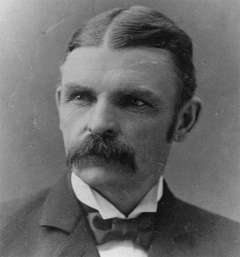
A prospector reported that he’d had a gunfight with three Indians, killing two despite being wounded in the chest. In fact he’d been shot by his prospecting partners. A party of Princeton students on a geological tour was believed to be in jeopardy, perhaps annihilated. In fact they had never felt unsafe. Two Jackson-area homes were robbed of bedding and clothing. In fact the thieves were six White men from Lander who had come to fight Indians.
In response to Gov. Richards’s request, five companies of troops from the Ninth Cavalry at Fort Robinson, Neb.—Black men known as “buffalo soldiers”—were dispatched to the railroad stop at Market Lake. At least one company then marched the 120 miles over Teton Pass into Jackson Hole. Arriving on Saturday Aug. 3, the soldiers found no dead settlers, no threatening Indians and no evidence of wasteful elk slaughter.
That same day, Thomas B. Teter, the agent at Fort Hall, reported, “All Indians absent from the reservation have returned. Had big council. Request me to telegraph you their hearts felt good. Had not harmed a white man, and would start haying, leaving grievances to the justice of the white man.”
The legal system
Outside of Wyoming, much sympathy lay with the Bannocks. For example, the army general in charge of the Ninth Cavalry, John J. Coppinger, said, “I do not consider the Indians to blame for the Jackson Hole affair. … They are entirely quiet now and have been. In fact they will not say ‘Boo’ to a goose.” Even Idaho newspapers mocked the “war” manufactured for the benefit of a small number of Jackson Hole guides.
The New York Evening Post wrote, “this was a case of massacre with premeditation. ... As to the ‘Bannock War’ [as it was already being called], there is no such thing. The Bannocks are only a handful, and they have lived at peace with the whites for seventeen years. The survivors of them are only anxious to save their own lives, and well they may be, considering how the white man’s law is executed in Wyoming.”
Indeed, Wyoming’s U.S. Attorney wrote, “The whole affair was, I believe, a premeditated and prearranged plan to kill some Indians. ... and ultimately have the Indians shut out from Jacksons Hole.” He called Se-we-a-gat’s death “murder.” But, he said, “there are no officials in Jacksons Hole—county, State, or national—who would hold any of Manning’s posse for trial.”
The United States Indian Service sent an inspector, Province McCormick, to try to sort out the situation. When McCormick met with Gov. Richards, General Coppinger and others, Richards “was unwilling to concede to the Indians any rights under their treaty to hunt in Wyoming,” McCormick reported. Following his superiors’ instructions, McCormick then proposed that they “make a test case” to decide the law, and Richards agreed to abide by its results.
McCormick then traveled to Fort Hall to set up the case. He and Teter selected two Bannocks to be tried for hunting in Wyoming. As part of that effort, McCormick wrote to his superiors, he assured a tribal council that “no effort would be spared to restore to them guaranteed rights and also the punishment of their murderers.” [McCormick used the italics for that word.] They merely had to trust in the White man’s law.
However, McCormick warned his superiors, “When this test case is decided, and the courts uphold (as I suppose they will) the treaty rights as guaranteed to these Indians … establishing the right of these Indians to hunt on public or unoccupied lands does not protect them in that right.” He worried that Wyomingites would not respect the decisions of courts. “Shooting down defenseless Indians is a greater source of revenue in the end than the tilling of the soil. They realize that it is not a crime in Wyoming to shoot an Indian.”
The Race Horse case
Of the two Bannocks in the test case, one (who may have been Ben Senowin) soon vanished from the record. The other, John Race Horse, Sr., had not been with Senowin but admitted to killing seven Wyoming elk as part of another hunting party. Teter, the Indian agent, took them to Evanston to be arrested. On Oct. 10, 1895, Teter reported that “the Indians, though in the custody of the Sheriff, are not aware of the fact of their arrest and, it is my intention to keep them in ignorance, owing to the bad effect it would have upon the Indians of the reservation.”
Indeed, Uinta County jail records show no Indians in custody in October, and no prisoners brought in by Teter. Nevertheless, the U.S. Attorney filed a writ of habeas corpus against the Uinta County sheriff, John H. Ward, for Race Horse’s release. The habeas strategy allowed the case to go to U.S. circuit court, rather than a potentially biased lower court. It also allowed for faster appeal to the U.S. Supreme Court, which gave priority to habeas cases. The Indian Service, confident of victory, wanted a ruling that could apply nationwide.
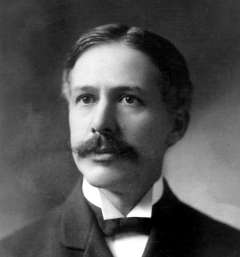
On Nov. 21, 1895, circuit judge John Riner sided with the feds and the Bannocks. He wrote, “State law must give way to [the federal government’s] superior authority. This rule is essential to the existence of the Federal Government. Without it, the constitution, laws, and treaties of the United States would be subject to overthrow at any time, at the will of the state.” He ordered Race Horse’s release.
Wyoming immediately appealed to the U.S. Supreme Court. At the Supreme Court, in March 1896, Wyoming attorney Willis Van Devanter argued the “equal footing” clause: Each state is admitted to the Union on an equal footing with other states. Since a state such as Vermont had been admitted without any Indian treaties diminishing its rights to regulate hunting, the same should hold for Wyoming. Otherwise Wyoming would lack the power, possessed by every other state, “to regulate the killing of game within [its] borders.”
In a seven-to-one vote issued on May 25, 1896, the Supreme Court reversed Riner’s decision. The Supreme Court ruling authored by Justice Edward Douglass White largely followed Van Devanter’s reasoning. As a territory, White wrote, Wyoming had been explicitly obligated to follow all Indian treaties. But its admission as a state contained no such explicit obligations; indeed the admission mentioned equal footing with other states.
“The march of advancing civilization foreshadowed the fact that the wilderness, which lay on all sides of the point selected for the reservation, was destined to be occupied and settled by the white man,” White wrote. Thus the hunting right was “temporary and precarious”; it was “essentially perishable, and intended to be of a limited duration.”
He cited the 1872 creation of Yellowstone, and the 1894 Lacey Act restricting hunting in Yellowstone, to show the freedom that White governments had to restrict Indians’ off-reservation treaty hunting rights. If Congress through those acts could restrict Bannock hunting rights in Yellowstone, so too could the state of Wyoming restrict those rights within its borders. (One justice was not present for oral arguments and thus took no part in the decision; the dissent by Henry Billings Brown claimed that under legal tradition, treaties with Indians had to be interpreted as Indians of the time would have understood them.)
Race Horse was arrested again, but prosecutors agreed that because this was a test case, he should be released. Residents of Jackson Hole had gotten what they wanted—an end to off-reservation hunting—and they felt no need to further punish Race Horse.
The Fort Hall tribes were obviously not happy with the decision. (Many Shoshone joined Bannocks at Fort Hall, where the governing body is now known as the Shoshone-Bannock Tribes Of The Fort Hall Reservation, or Sho-Bans.) Their trust in White law had been misplaced.
Yet this was merely one of a string of broken promises. They had also lost their treaty-reserved rights to collect camas roots at an off-reservation site in central Idaho, as well as their rights to the irrigation water that might make their reservation land suitable for agriculture. In 1888, they’d had to cede 1,800 acres of their reservation because railroad companies wanted to develop the current city of Pocatello. Because the city was growing, in 1898 they had to cede another 418,560 acres; when the cession was formally opened to White settlement in 1902, 6,000 Pocatello residents took part in a “Day of the Run” to claim those lands. In the coming decade their lands would be further fragmented by allotment, and the Bannocks would be forced to absorb the Lemhis, whose reservation near Salmon, Idaho, was eliminated.
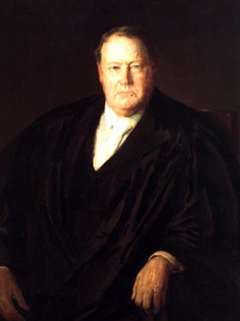
Decisions of the 1896 Supreme Court have not aged well. Most famously, the Plessy v. Ferguson ruling, issued just one week before Race Horse v. Ward, enshrined the “separate but equal” doctrine that legitimated racial discrimination against Blacks for another sixty years. The warped legacy of Race Horse would last even longer.
The Herrera case
On Jan. 18, 2014, Clayvin Herrera and some friends and relatives went elk hunting. As members of the Apsáalooke Nation—the Crow Tribe—they could legally hunt on their Montana reservation. Herrera had three daughters to feed despite a recent cut in his pay; the poverty rate on the reservation was at 30 percent and rising. Herrera’s party spotted some elk, and followed the animals across the border into Wyoming onto land managed by the Bighorn National Forest. There they killed three elk, and packed out the meat. In the Indigenous tradition, they distributed it widely in their community.
Wyoming officials cited Herrera, his brother and a friend for “Taking an Antlered Big Game Animal Without a License or During a Closed Season.” The others reached plea agreements, and thus soon vanished from the record. But Herrera himself decided to fight the charges (he was also charged with being an accessory to the others committing the same violation). Before the trial even began, Herrera’s attorneys moved to dismiss the charges because he had a treaty right to hunt elk off the reservation. A series of Wyoming courts, and the federal Tenth Circuit, declined to intervene: Herrera needed to face a jury.
In Sheridan County Circuit Court, Herrera admitted shooting the elk. He wanted to argue that the action was legal under his treaty rights, but the Wyoming court ruled that he wasn’t allowed to make that argument—in legal terms, he was precluded from making that argument. He tried other arguments, which were not persuasive. The jury found him guilty. Although the charge was a misdemeanor, the fine was $8,000, plus a year of probation and a three-year ban on hunting.
Herrera appealed. A higher state court upheld his conviction. He appealed again. The Wyoming Supreme Court declined to review his conviction. He appealed again, and the U.S. Supreme Court agreed to hear his case in Herrera v. Wyoming.
The Supreme Court was interested in three potentially controversial legal issues. The first was preclusion, which is a rich subject for arcane legal arguments. The reason Herrera couldn’t argue his treaty rights, the lower judges had said, was that he was bound by the results of a previous case. In 1994, the federal Tenth Circuit Court of Appeals had ruled against a Crow tribal member who had similarly killed an elk in the Bighorn National Forest. This case, known as Repsis (full name: Crow Tribe of Indians v. Repsis; Chuck Repsis was the Wyoming Game and Fish agent who made the arrest), was a declaratory judgment suit filed by the Crow tribe as a whole. Once the tribe lost Repsis, no tribal member could re-litigate its issues.
The second interesting legal issue was Race Horse, the 1896 ruling that off-reservation treaty hunting rights had been extinguished at statehood. Repsis relied on Race Horse. But in a 1999 decision on a case in Minnesota, known as Mille Lacs (full name: Minnesota v. Mille Lacs Band of Chippewa Indians), the U.S. Supreme Court rejected the Race Horse reasoning that “equal footing” should imply that treaty rights were terminated at statehood.
In Mille Lacs, the Court stopped short of explicitly overruling Race Horse. But maybe it was time to finally do so? After all, the Race Horse ruling had a checkered history. For one thing, it didn’t help the elk: Wyoming game numbers continued to decrease from 1896 through the 1920s. Beginning in 1897, blame started settling on wolves, coyotes and mountain lions.
But what interested the Supreme Court was legal precedents: Only one subsequent Supreme Court opinion, in 1916, relied on Race Horse, and lower courts continually rejected it and the equal footing doctrine. A 1982 law handbook, Cohen's Handbook of Federal Indian Law, stated that Race Horse was “an anomaly, probably the only case where the Court has held an Indian treaty right [was] extinguished based on doubtful and ambiguous expressions of Congressional intent.” The issue wasn’t whether Congress could singlehandedly alter conditions of an Indian treaty—it could. But many legal experts thought it needed do so formally and explicitly. By contrast, Race Horse relied on implications of other developments such as statehood.
A third interesting issue for the Supreme Court was that Repsis had held that even if statehood didn’t end the Crows’ treaty hunting rights, the establishment of the Bighorn National Forest in 1897 did, because it meant that the land in question was no longer “unoccupied.” Indeed, the Wyoming Stockgrowers Association and other agricultural groups filed a Herrera brief in support of the state, arguing that a rancher who leased National Forest land for grazing was occupying it—any other interpretation would present the rancher with undue burdens.
Herrera’s lawyers countered that the proclamation establishing the Forest had precluded “entry or settlement” on the land (and the Forest Reserve Act of 1891 had prohibited any forest establishment from abrogating Indian treaties). “No ordinary English speaker would understand a prohibition on the entry or settlement of vast, empty, and undisturbed land to mean that the land suddenly became ‘occupied,’” they wrote.
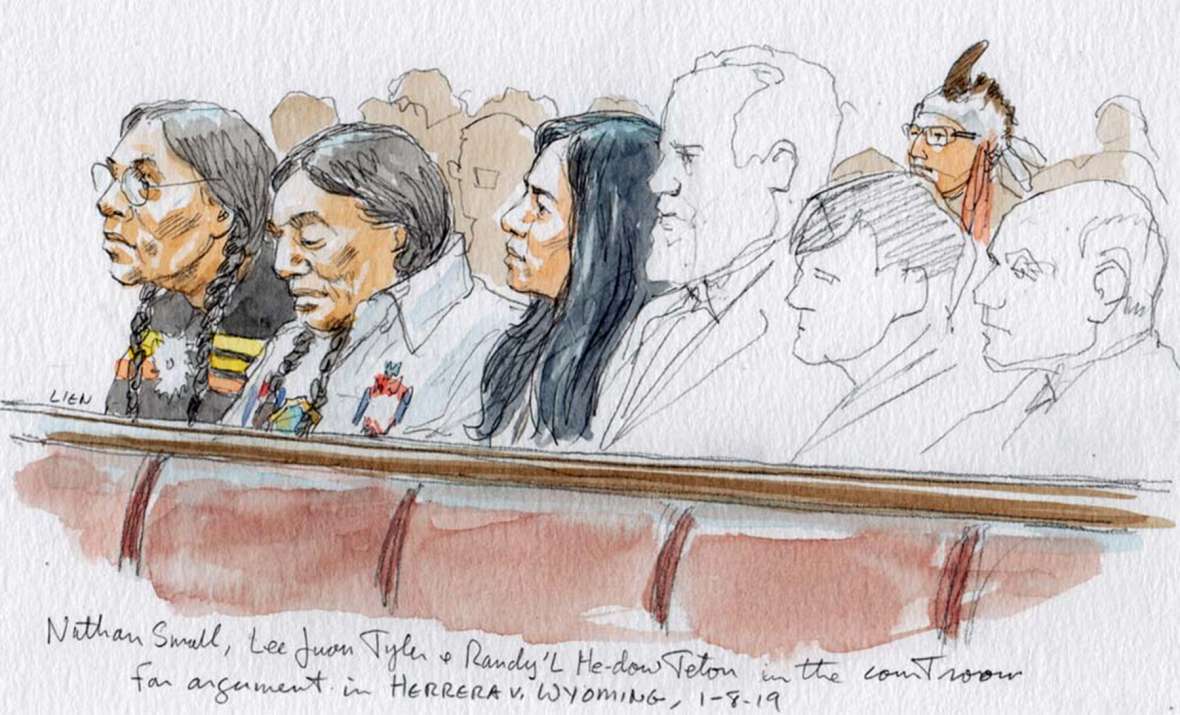
A landmark opinion
Although Herrera was so technical that it never gained much popular attention, it was widely followed within the legal profession. For example, the U.S. Solicitor General, in charge of interpreting federal law for the federal government, not only filed a brief on Herrera’s behalf, but also participated in the Supreme Court’s oral arguments. A law professor who attended those oral arguments, on Jan. 8, 2019, called the session “one of the most dramatic I can recall.” Numerous legal blogs weighed in, with at least one quipping that the Supreme Court might “put Race Horse out to pasture once and for all.”
The Supreme Court issued its ruling on May 20, 2019. A five-to-four decision authored by Justice Sonia Sotomayor found for Herrera. Repsis did not preclude Herrera from arguing that statehood affected treaty rights, it said, because Mille Lacs represented a significant intervening change in the law. “Applying Mille Lacs, this is not a hard case,” the opinion said; Wyoming’s mistake had been to ignore Mille Lacs. To avoid similar future mistakes, the Herrera opinion took the step that Mille Lacs hadn’t, quite: “[W]e make clear today that Race Horse is repudiated to the extent it held that treaty rights can be impliedly extinguished at statehood.” Furthermore, it said the term unoccupied had to be interpreted as indigenous people of 1868 would have understood it: “free of residence or settlement by non-Indians.” Establishing the Bighorn National Forest didn’t occupy the land.
A dissent authored by Justice Samuel Alito focused on preclusion. Repsis was a complicated decision, and regardless of Mille Lacs, Alito claimed, portions of Repsis still precluded Herrera from arguing for his treaty rights.
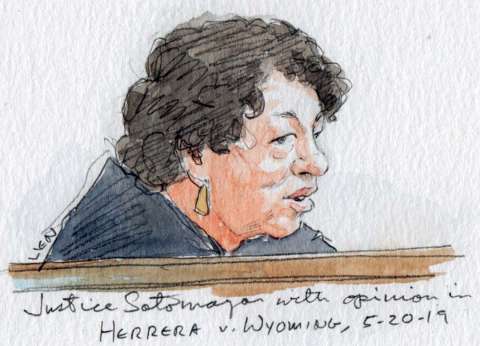
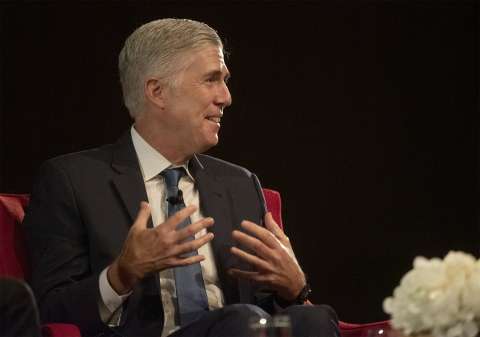
Perhaps the most notable feature of the Herrera decision was that Justice Neil Gorsuch, a westerner with uniquely thorough experience in federal Indian law, broke with other conservative justices to join Sotomayor in favor of Herrera. Gorsuch would later expand that position in the 2020 McGirt v. Oklahoma decision. In McGirt, Oklahoma argued that statehood had disestablished the Muscogee (Creek) Nation reservation; the Gorsuch-authored McGirt opinion continued the Herrera reasoning by again saying that if Congress has not taken explicit action to change an Indian treaty, treaty rights remain in force.
An ongoing case
Some hunters fear that Herrera means that Crow hunters can indiscriminately slaughter wildlife. However, that’s not the way it works in other, similar situations. Among other states, Montana and Colorado have long accommodated off-reservation hunters from the Confederated Salish and Kootenai Tribes and the Ute tribe, respectively.
In August 2019, the Crow legislature adopted changes to its game code to regulate off-reservation treaty hunting on unoccupied federal lands in Montana and in Wyoming’s Bighorn National Forest. Thus, Montana has instructed game wardens not to cite Crow tribal members who violate state hunting laws in the Custer Gallatin National Forest (adjacent to the reservation, and once part of it), or crossing the border from the Bighorn. Montana now understands these hunters to be regulated by tribal laws.
It's not unusual for states and tribes to collaborate on natural resource management. For example, the Wind River Reservation Tribal Game and Fish Department has worked with Wyoming Game and Fish and the U.S. Fish and Wildlife Service to dramatically increase elk, deer and pronghorn populations on the reservation since 1982. The Sho-Ban tribes have worked on off-reservation salmon recovery in Idaho. If, as expected, the Custer Gallatin National Forest formally recognizes Montana’s Crazy Mountains as an “area of tribal interest,” the Crow tribe will collaborate on management of the Crazies. Such collaboration often means lots of hard work, but may be the answer in a post-Herrera world.
However, the post-Herrera world is not yet here. The Supreme Court didn’t fully decide Herrera’s fate. Although it held that the entire Bighorn Forest couldn’t be occupied, it allowed that portions might be. It also noted that Wyoming does have the right to regulate hunting due to a complicated doctrine that goes under the shorthand conservation necessity. It sent Herrera’s case back to the Wyoming state courts to amass evidence and decide those issues.
In a first step, prosecutors urged the Sheridan County Circuit Court to again address preclusion. On June 11, 2020, judge Shelley Cundiff agreed that although Repsis had not precluded Herrera from arguing about statehood, it did still preclude him from arguing about occupation and conservation necessity. Repsis had ruled that the Bighorn Forest was occupied, and that conservation necessity required Crow hunters to follow all Wyoming Game and Fish regulations. After all, prosecutors point out, the elk herd is a resource that exists only because of a century’s worth of conservation management by the state of Wyoming. (For example, the state runs 23 elk feedgrounds in Teton, Sublette and Lincoln counties.) And at the time of Herrera’s 2014 elk kill, the Crow tribe had not yet established any regulation on tribal hunting in Wyoming.
Mille Lacs had addressed only statehood, not occupation or conservation necessity, Cundiff’s ruling said. Thus those sections of Repsis still couldn’t be re-litigated by a Crow tribal member. Because Herrera was precluded by Repsis from addressing occupation or conservation necessity, the ruling said, there was no point in lengthy proceedings to amass evidence about them.
Herrera’s attorneys have appealed, and will likely argue that the Supreme Court told the lower courts to rule on facts about occupation and conservation necessity, rather than again getting bogged down in Repsis and preclusion. That appeal is in process; it’s quite possible that the case will head all the way back to the U.S. Supreme Court.
Elk
These developments put the Sho-Ban and Eastern Shoshone tribes in a curious position. With Race Horse now repudiated, their treaty hunting rights have seemingly been validated again. These tribes were not parties in Repsis, which means that the preclusion issues so central to Herrera cannot apply to them. According to federal law, they can again hunt in Wyoming’s national forests—but what about Wyoming law? What happens if a Wyoming game warden encounters an Indian hunting without a Wyoming license, or out of Wyoming’s season? It’s as if we have finally reached the resolution that Indian Service inspector Province McCormick expected in 1895: “When this test case is decided, and the courts uphold (as I suppose they will) the treaty rights as guaranteed to these Indians…” will it have any effect in Wyoming?
Beneath all of the legal twists is an underlying historical issue: elk. Access to elk hunting has always been what’s at stake. In 1895, Jackson Hole residents used violence to deny that access to Bannocks, so they could build an economy selling that access to out-of-staters. The 1896 Supreme Court wholeheartedly agreed with them. More recently, as Wyoming denied that access to Crows, the Supreme Court has been more skeptical.
There’s been one other change in 125 years: Wyoming elk populations are no longer dwindling. Quite the opposite. In 2020, the Wyoming Game and Fish Department estimated that statewide elk populations were 32 percent above objectives. Among the geographical units with excess elk populations were the North Bighorn unit, adjacent to the Crow reservation, and the Hoback, Afton and Upper Green River units, areas hunted before 1895 by the Bannock and Shoshone. “If you’re an elk hunter, it doesn’t get any better than it is now in Wyoming,” Doug Brimeyer of Wyoming Game and Fish told WyoFile. But who gets to hunt Wyoming’s elk?
Resources
- Daugherty, John, et al. A Place Called Jackson Hole: A Historic Resource Study of Grand Teton National Park. Moose, Wyo.: Grand Teton Natural History Association, 1999. Chapter 17: Conservationists, accessed Aug. 26, 2020 at https://www.nps.gov/parkhistory/online_books/grte2/hrs17a.htm.
- Leek, Stephen N. “Chapters from the Eventful History of Jackson’s Hole.” 1939 typescript. Jackson Hole Historical Society and Museum, Jackson, Wyo.
- Madsen, Brigham D. The Northern Shoshoni. Caldwell, Idaho: Caxton Press, 1980, 134–138.
- Spence, Mark David. Dispossessing the Wilderness: Indian Removal and the Making of the National Parks. New York and Oxford: Oxford University Press, 1999, 62–69.
- U.S. Commissioner of Indian Affairs. Annual Report of the Commissioner of Indian Affairs to the Secretary of the Interior 1895. Washington, DC: Government Printing Office, 1895, 60-80, and U.S. Commissioner of Indian Affairs. Annual Report of the Commissioner of Indian Affairs to the Secretary of the Interior 1896. Washington, DC: Government Printing Office, 1896, 56-70, both accessed Aug. 26, 2020 at https://books.google.com/books?id=mWW5NNA_KtQC&pg=RA5-PA56&lpg=RA5-PA56&dq=wyoming+bannock+1895&source=bl&ots=asGKAwLg5A&sig=ACfU3U3z4OaCx4J1aWjrb9-xtWwrmGXwUg&hl=en&sa=X&ved=2ahUKEwid-qaLtaXqAhXHKM0KHbIaCs4Q6AEwDXoECAwQAQ#v=onepage&q=wyoming%20bannock%201895&f=false. Portions reproduced in “Indian Disturbances in ‘Jackson Hole’ Country, Wyoming, 1895.” Annals of Wyoming 16, no.1, 5–33, accessed Aug. 26, 2020 at https://archive.org/details/annalsofwyom16121944wyom/page/32/mode/2up?q=van+ors.
- Warren, Louis S. The Hunter's Game: Poachers and Conservationists in Twentieth Century America. New Haven: Yale University Press, 1997.
- Wight, Jermy. The Jackson Hole Conspiracy 1895. Afton, Wyo.: Timberline Press, 2007. Includes 125 pages of transcriptions of 1890s newspaper articles, plus other reproduced primary sources.
Legal sources
- Brief of Amicus Curiae Shoshone-Bannock Tribes of the Fort Hall Reservation in Support of Petitioner at 26–28, Herrera (No. 17-532, Sept. 11, 2018), accessed Aug. 26, 2020 at https://www.supremecourt.gov/DocketPDF/17/17-532/63310/20180911132729339_17-532tsacShoshoneBannockTribes%20FINAL.pdf. Contains historical information not available in other published sources, thanks to the research of Sho-Ban attorney William Bacon.
- Cohen, F. Handbook of Federal Indian Law. (1982 ed.) Ch. 5, Sec. A4 at 268 n. 73. Quoted in the Repsis decision, https://law.justia.com/cases/federal/district-courts/FSupp/866/520/1376074/
- Crow Tribe of Indians v. Repsis, 866 F. Supp. 520 (D. Wyo. 1994), accessed Aug. 26, 2020 at https://law.justia.com/cases/federal/district-courts/Fsupp/866/520/1376074/.
- HERRERA v. WYOMING Certiorari to the District Court of Wyoming, Sheridan County No. 17–532 [Supreme Court opinion and dissent], accessed Aug. 26, 2020 at https://www.supremecourt.gov/opinions/18pdf/17-532_q86b.pdf. See also Petition for Writ of Certiorari, HERRERA v. WYOMING, Oct. 5, 2017, [Herrera’s argument], accessed Aug. 26, 2020 at https://www.scotusblog.com/wp-content/uploads/2018/01/17-532-petition.pdf. Numerous other files related to this case are linked from https://www.scotusblog.com/case-files/cases/herrera-v-wyoming/.
- STATE OF WYOMING v. CLAYVIN B. HERRERA, Sheridan County Case Number CT 2014-2687; 2688, Order on State’s Request for Post-Remand Issue Preclusion. June 11, 2020, accessed Sept. 8, 2020 at https://turtletalk.files.wordpress.com/2020/06/herrera-circuit-court-remand-order.pdf.
- “Treaty with the Shoshonee and Bannacks, July 3, 1868.” Jackson Hole Historical Society and Museum, accessed July 14, 2020 at http://jacksonholehistory.org/wp-content/uploads/1868-treaty.pdf.
News and analysis
- Ablavsky, Gregory. “Argument analysis: Justices grapple with preclusion and ‘occupation’ in Crow Tribe treaty case.” SCOTUSblog, Jan 9, 2019, accessed Aug. 26, 2020 at https://www.scotusblog.com/2019/01/argument-analysis-justices-grapple-with-preclusion-and-occupation-in-crow-tribe-treaty-case/.
- _______________. “Opinion analysis: Court rejects issue preclusion in affirming Crow Tribe’s treaty hunting right.” SCOTUSblog, May 20, 2019, accessed Aug. 26, 2020 at https://www.scotusblog.com/2019/05/opinion-analysis-court-rejects-issue-preclusion-in-affirming-crow-tribes-treaty-hunting-right/.
- Darrow, Allayana. “Court: Tribal members must obey state hunting rules.” Sheridan Press, June 19, 2020, accessed Aug. 26, 2020, at https://www.gillettenewsrecord.com/news/wyoming/article_02dd6f12-8e14-51a5-a222-70320247d544.html.
- Epps, Garrett. “Can Congress Void a Tribal Treaty Without Telling Anyone? What’s at issue in Herrera v. Wyoming.” The Atlantic, Jan. 13, 2019, accessed Sept. 14, 2020 at https://www.theatlantic.com/ideas/archive/2019/01/herrera-v-wyoming/580243/.
- “Fish and Wildlife.” Shoshone-Bannock Tribes, accessed Sept. 20, 2020 at http://www2.sbtribes.com/fish-and-wildlife/.
- French, Brett. “Montana honors Crow treaty rights in Custer Gallatin National Forest.” Billings Gazette, June 2, 2019, accessed Aug. 26, 2020 at https://billingsgazette.com/outdoors/montana-honors-crow-treaty-rights-in-custer-gallatin-national-forest/article_eb190bff-67e3-5ec4-8427-6a616e53e421.html. French has done groundbreaking reporting on most local aspects of the case.
- Lungren, Sam. “Herrera v. Wyoming: Inside the Elk Hunting Case Before the Supreme Court.” TheMeatEater.com, Feb. 13, 2019, accessed Aug. 26, 2020 at https://www.themeateater.com/conservation/policy-and-legislation/inside-the-elk-hunting-case-before-the-supreme-court.
- Mills, Monte. “Response, Herrera v. Wyoming: A New Trend for Indian Law?” Geo. Wash. L. Rev. On the Docket, June 11, 2019, accessed Aug. 26, 2020 at https://www.gwlr.org/herrera-v-wyoming-a-new-trend-for-indian-law.
- Mitchell, Jason. "Unoccupied: How a Single Word Affects Wyoming’s Ability to Regulate Tribal Hunting Through a Federal Treaty; Herrera v. Wyoming." Wyoming Law Review 19, no. 2 (2019), accessed Sept. 8, 2020 at https://scholarship.law.uwyo.edu/wlr/vol19/iss2/9.
- Montana State University Extension Service. “Crow Reservation: Montana Poverty Report Card,” accessed Aug. 26, 2020 at https://www.montana.edu/extensionecon/countydata/Crow.pdf.
- “National Forest Week: Crow Tribe Celebrates Recognition in MT forest.” Public News Service, July 15, 2020, accessed Sept. 20,2020 at https://www.publicnewsservice.org/2020-07-15/native-american/national-forest-week-crow-tribe-celebrates-recognition-in-mt-forest/a70863-1.
- Nie, Martin. "The Use of Co-Management and Protected Land-Use Designations to Protect Tribal Cultural Resources and Reserved Treaty Rights on Federal Lands." Natural Resources Journal 48, no. 3 (2008): 585-647, accessed Aug. 30, 2020 at http://www.jstor.org/stable/24889146.
- Rice, Daniel B. and Jack Boeglin. “Herrera v. Wyoming: A Cautionary Encounter with Careless Repudiation.” Balkinization, Jan. 18, 2019, accessed Aug. 26, 2020 at https://balkin.blogspot.com/2019/01/herrera-v-wyoming-cautionary-encounter_18.html.
- Thuermer. Angus M. Jr. “‘Decade of the elk’ for hunters as herds top goals by 32%.” WyoFile, Sept. 15, 2020, accessed Sept. 20, 2020 at https://www.wyofile.com/decade-of-the-elk-for-hunters-as-herds-top-goals-by-32/.
- Turck, Andrew. “Battle of ‘two sovereigns.’” Big Horn County [Montana] News, Jan. 17, 2019, accessed Aug. 26, 2020 at http://archives.etypeservices.com/Bighorn1/Magazine257887/Publication/Magazine257887.pdf.
For further reading and research
- Gerst, Ellen. "Crow Tribe wants court ruling voided." Casper Star-Tribune, Feb. 3, 2021, accessed March 3, 2021 at https://trib.com/news/state-and-regional/crime-and-courts/crow-tribe-fil....
- Koshmrl, Mike. "Post-Herrera, Wyoming seeks hunting pacts with tribes." WyoFile, Jan. 13, 2023, accessed Jan. 13, 2023 at https://wyofile.com/post-herrera-wyoming-seeks-hunting-pacts-with-tribes.
- Stagner, Taylar Dawn. “Who Gets a Say in Tribal Treaty Hunting?” High Country News via WyoFile, accessed May 10, 2023 at https://wyofile.com/who-gets-a-say-in-tribal-treaty-hunting.
Illustrations
- The Remington sketch of Bannocks fording the Snake River is from the Frederic Remington Art Museum, a gift of Mr. and Mrs. Donald Leary. It was first published in “The Bannock Affair,” an article in Harper’s Weekly, Aug. 10, 1895. Used with permission and thanks.
- The 1922 photo of constable William Manning is from the Jackson Hole Historical Society and Museum. Used with permission and thanks.
- The photos of Stephen Leek, Gov. William Richards, Justice Edward Douglass White and Justice Neil Gorsuch are all from Wikimedia Commons. Used with thanks.
- The photo of Willis Van Devanter is from Wyoming State Archives. Used with permission and thanks.
- The photo of Battle Mountain is from summitpost.org. Used with thanks.
- Art Lien’s sketches of the four members of the Shoshone-Bannock Tribe listening to Supreme Court arguments and of Justice Sonia Sotomayor are from SCOTUSblog. Used with thanks.
